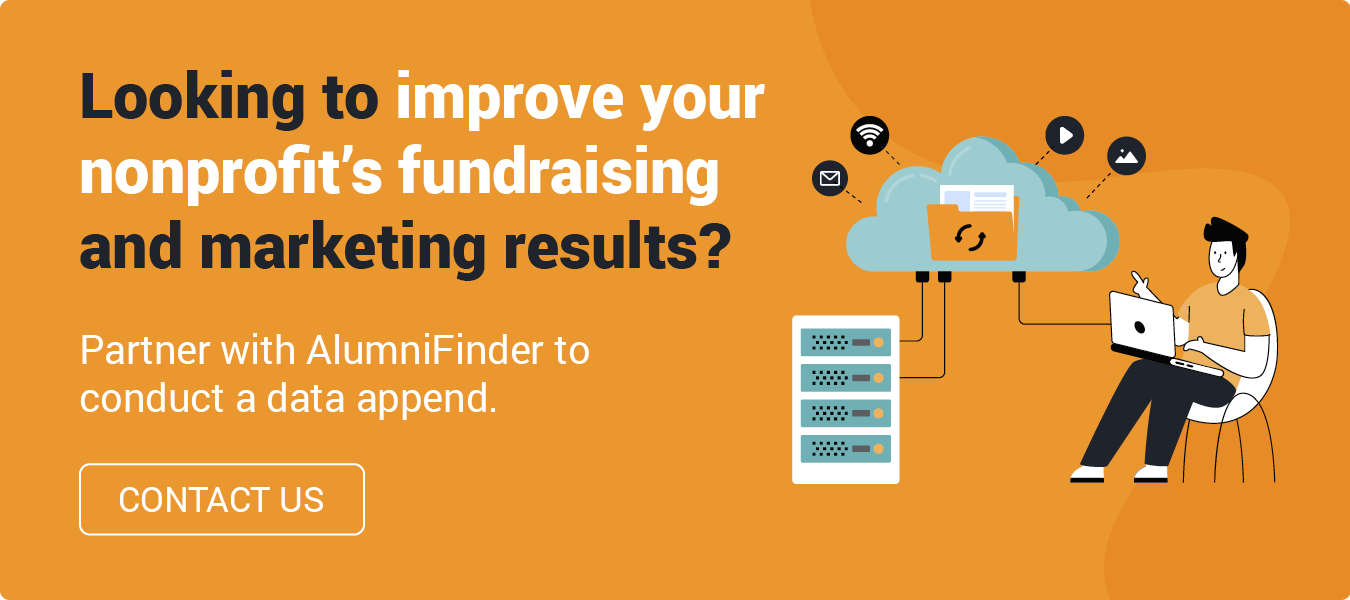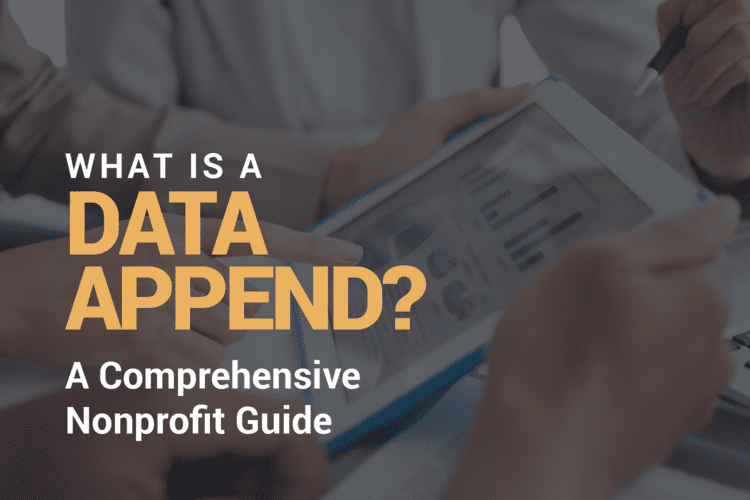
As a nonprofit professional, you likely interact with data daily. From managing your weekly volunteers to gathering donor communication preferences, your nonprofit needs to work with clean, complete data points to raise money, market your programs, and achieve your mission.
But what do you do when your organization’s data is limited or incomplete? While you can certainly collect data by sending out surveys and forms to the contacts in your database, this process is often slow and ineffective in gathering the data most valuable to your nonprofit.
That’s where third-party data appends—which add supplemental data points to your nonprofit’s existing records—come in. With data appends, the sky’s the limit for leveraging data in your nonprofit’s operations. This guide breaks down the various elements of the data append process so you can append data with confidence and ease. We’ll look at:
- Data Append FAQ
- Types of Data Appends
- Leveraging Your Nonprofit Data Appends
- How to Choose the Best Data Append Services
As you read this guide, consider the data you already have in your database. Ask yourself: What data points do we use the most often? Do these data attributes contain any errors, inaccuracies, or duplicates? What information would make our jobs easier and our outreach more effective? Your data appends will be more impactful when your existing data is clean, accurate, organized, and up-to-date.
Data Append FAQ
Data appends are unfamiliar to many in the nonprofit sector. You probably sense that your nonprofit’s data is essential, but you may not be sure how to get the most out of the information in your database. In this section, we’ll answer your questions about data appends and the data append process.
What is a data append?
A data append involves supplementing your database with information from third-party sources. When you combine your first-party data with information from outside sources, you can ensure your database is as comprehensive as possible and reflects your current supporter base.
The types of information you may append include:
- Contact information
- Demographics
- Wealth and philanthropic data
- Firmographic information, or data pertaining to businesses
A wide variety of organizations use data appends to learn more about their constituents or customers, reach them with the correct contact information, and personalize their communications to them. For example, a business may append email addresses for their customers so they can promote their new product via an email marketing campaign.
In terms of nonprofits, data append services allow charitable organizations to gather more information about their supporters so they can tailor their fundraising and marketing strategies accordingly.
Why is a data append important?
For nonprofits big and small, data is critical in making smart fundraising and marketing decisions. According to Target Analytics® research, the average nonprofit misses out on $3,781,461 in supporters’ untapped giving potential. Simply put: Without data, you may be missing out on opportunities to further your mission.
With a data append, you can use the information you gain to make more informed decisions. This additional data rounds out your database, allowing your nonprofit to: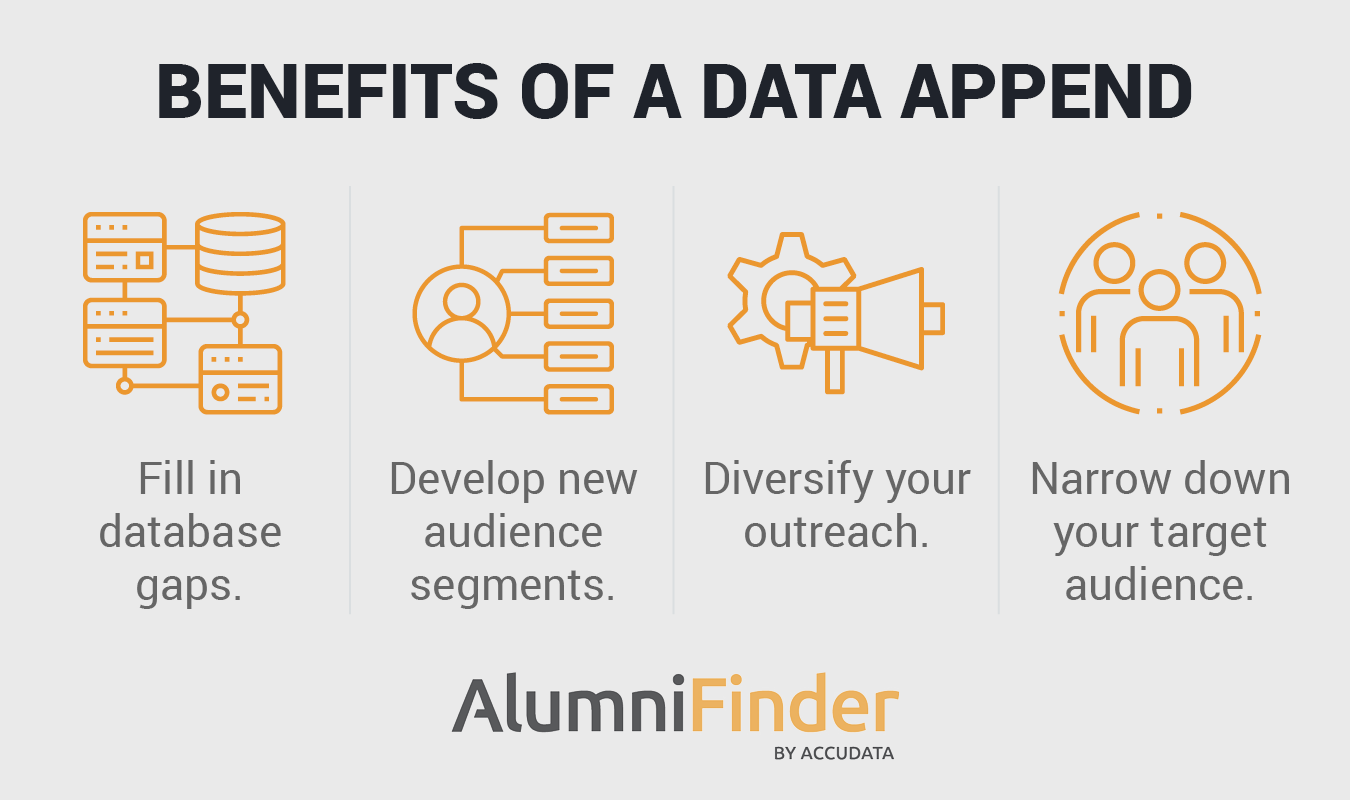
- Fill in database gaps. In the past, your nonprofit may have sent surveys with optional fields or have only requested a singular piece of contact information from each supporter. To get any important contact or demographic information you’re missing, you can use a data append.
- Develop new audience segments. Let’s say your nonprofit has just created a new branch in Seattle. Appending geographic data would allow your organization to identify donors in the Seattle area and target them with communications about local engagement opportunities.
- Diversify your outreach. If you’ve focused on certain marketing methods in the past but want to expand your efforts, append contact information that will enable you to unlock different marketing channels. For instance, you can pivot from offline marketing to digital marketing by appending email addresses and phone numbers.
- Narrow down your target audience. The more information you have about your donors, the better you’ll be able to target them with relevant communications and gain their continued support. For example, if you’re running a capital campaign, you may append wealth and philanthropic information to identify potential major donors. Then, you can target only those with the highest giving capacity.
With the help of a data append provider, you can determine the data you need to reach your fundraising and marketing goals. Their team of data experts can then help you acquire the information you’re looking for and add it to your database to supercharge your next campaign.
How do data append services work?
You want to make a difference in your community, not spend your days typing data points into your CRM one-on-one. But, clearly, your success also relies on effective outreach to volunteers and donors. For nonprofits, a data append service can save you time and energy by enabling the data append process in batch.
Generally, when working with a data append service, the process follows four simple steps:
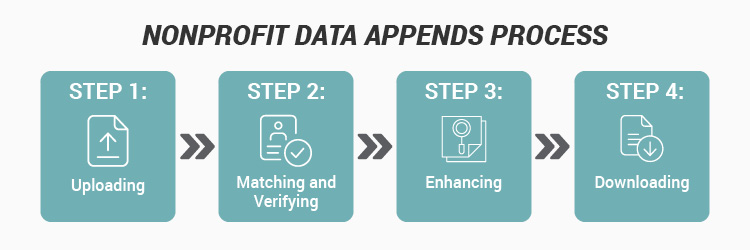
- Step 1: Uploading. To perform a batch append, you’ll upload your existing data to your data append service provider all at once.
- Step 2: Matching and Verifying. Uploaded records are verified and matched with corresponding entries in the append service’s extensive external databases.
- Step 3: Enhancing. Depending on the type of outreach or marketing you’re planning, you’ll select the data attributes you’d like appended.
- Step 4: Downloading. Finally, you’ll download these attributes to append the corresponding records to your database.
Once the relevant data attributes are appended to existing records, leverage this information to determine when and how to reach out to supporters. For example, you could append a newsletter subscriber’s geographic data and send them personalized recommendations for upcoming events in their area.
Types of Data Appends
Data providers hold an immense amount of data points available for your nonprofit to use in its marketing and outreach campaigns. Yet, deciding what data will be helpful to your organization can be a difficult task.
We’ve compiled a list of the most important information to consider appending to your nonprofit database and why you might want access to this data. Then, discuss with your team which data types will support your organization’s goals.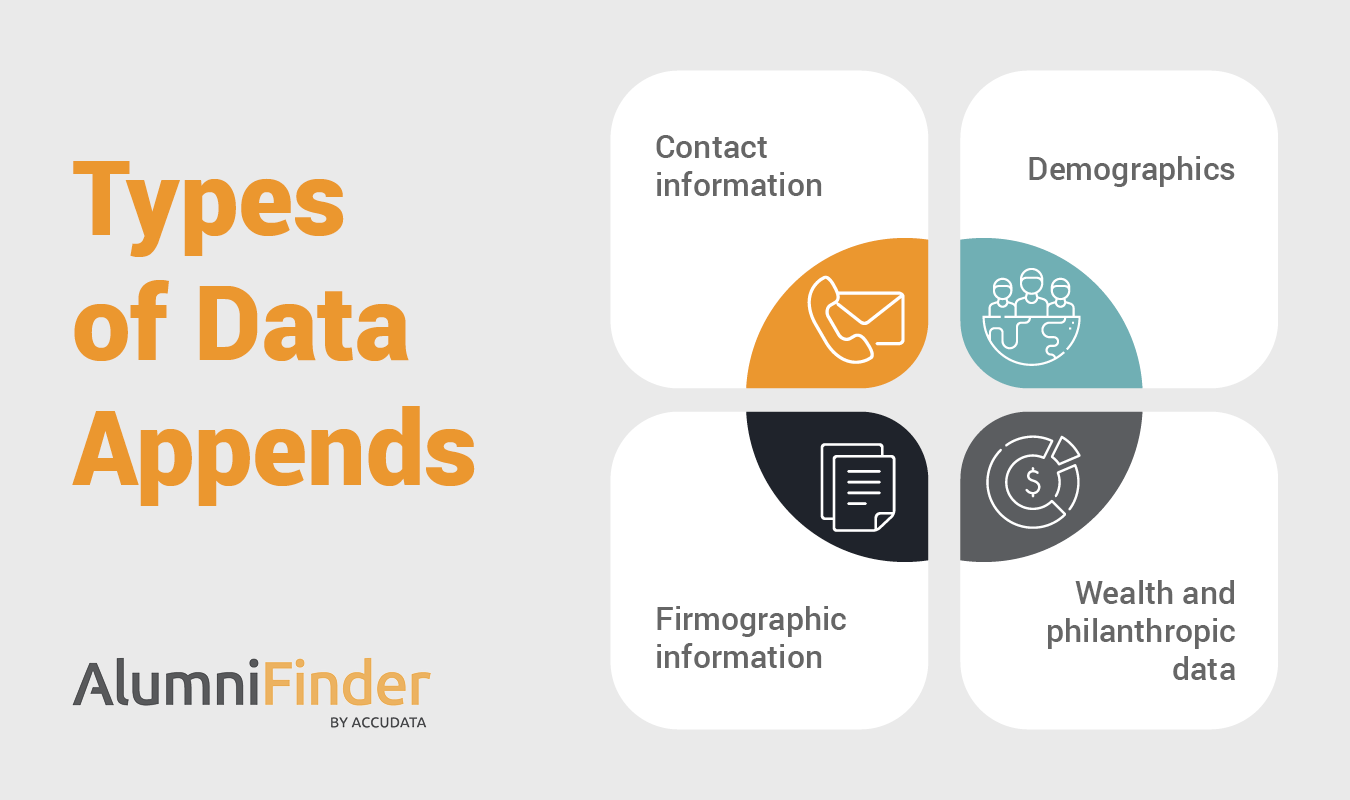
Contact Information
Did you know that about 30 million Americans move each year? Between constituents moving, getting new phone numbers, or switching email addresses, their contact information can quickly become outdated.
To ensure you can continue reaching and communicating with your supporters, append data such as:
- Postal addresses. While many modern marketers focus on digital marketing, direct mail is still a powerful way to reach your target audience. Having a physical reminder of your organization in their hands will inspire supporters to take action and contribute to your cause. Appending postal addresses ensures your direct mail campaigns reach your supporters, even if they’ve recently moved.
- Phone numbers. With a phone append, you can add phone numbers to your records, allowing you to run text marketing campaigns or call your donors. This is especially valuable for connecting with major gift donors who may prefer more personalized communications. Additionally, you can run a reverse phone append to add email or address contact information based only on the phone numbers in your records.
- Email addresses. Email is one of the most efficient, cost-effective methods for a nonprofit to reach supporters. As with phone numbers, you can append active email addresses to incomplete records.
- Social media handles. With 62.3% of the global population on social media, it’s crucial to leverage these platforms in your engagement strategy. Appending social media information allows you to better update and engage your supporters in real time.
Before you can personalize your communications to your audience, you must first be able to reach them. Appending contact information allows your organization to be confident that its outreach efforts will go to its intended audience.
Demographics
Once you have your supporters’ contact information, consider appending additional demographic data to best tailor your marketing approach to different segments of your target audiences.
For example, if you’re a nonprofit sending an email with information about volunteer opportunities in your community, you’d likely want to address it only to your local supporters. Otherwise, you risk bothering donors in other cities who wouldn’t find those opportunities engaging or valuable
Let’s take a closer look at the kinds of demographic data you can get from a demographic append:
- Age and date of birth
- Gender
- Ethnicity
- Religion
- Marital status
- Presence of children
- Education
- Hobbies and interests
By appending these data points, you can better understand your audience and use this information to develop and target ideal donor personas.
Wealth & Philanthropic Information
Wealth and philanthropic information can help you focus your attention on donors who have the greatest capacity and propensity to give. Consider the following wealth and philanthropic data appends for your nonprofit:
- Employment details. You might append this data (including their employer’s name, their job title, and their income) to assess giving potential and suggest matching gift opportunities.
- Giving history. If you know which causes interest your donors, you can better market your mission to align with their values. This information might include the number and size of gifts, gift recipients, and association with grant-giving foundations.
- Assets. You can append information regarding individuals’ real estate holdings, airplane or boat ownership, and stock ownership to your records to assess their financial capacity to contribute to your organization. Plus, knowing about donors’ stock holdings can help you solicit donations of stock from these supporters.
When you identify donors with a high giving capacity and interest in contributing to your cause, you can develop a stronger, data-driven major gift strategy and secure more funding for your nonprofit.
Firmographic Information
In addition to individual donors’ data, your database may store information about businesses and foundations that support your nonprofit with grants, matching gifts, and in-kind donations.
Just as you append individual data, you can also append business information with firmographic data, such as:
- Contact information
- Type of business
- Number of employees
- Sales volume
- Job titles
However, before appending any data, determine precisely why you want this information and how you’ll use it to meet your goals. Otherwise, all you’ve gained is more data to manage.
For example, if you’re fundraising for a university foundation, you may want to append the current contact information of your alumni. On the other hand, if you’re a nonprofit expanding your reach into a new city, you may want to append your database with local demographic, geographic, and firmographic information. Below, we’ll look at how data appends can help nonprofits engage donors and raise funds.
Leveraging Your Nonprofit Data Appends
Generally, data appends accomplish two basic tasks for your nonprofit: filling in gaps in your records and supplementing existing data. However, you can also achieve several more specific goals related to targeting the right audience for your fundraising campaigns. Data append services can help your nonprofit:
- Tailor your existing fundraising campaigns. Nonprofit data appends allow you to get a fuller picture of your supporters. As a result, you can better target them based on their demographics, interests, and preferences and create more appropriate fundraising asks.
- Quickly capitalize on fundraising opportunities. When you have more accurate, complete contact information, you can take advantage of rapid forms of communication—such as social media and text messaging—to instantly reach supporters with your appeals.
- Identify potential major donors. An overwhelming 88% of funds raised by nonprofits come from 12% of donors. With the right data append services, you can pinpoint potential major donors in your database and start cultivating gifts that can completely transform your organization’s operations.
Ultimately, the benefits of nonprofit data enhancement boil down to efficiency and effectiveness. While dirty and incomplete data can result in costly errors, data appends can simultaneously save your organization time and money that you can put back into the work you do for your community.
How to Choose the Best Data Append Services
As you can imagine, conducting data appends on your own can be a time-consuming, labor-intensive process. Luckily, there are many automated tools and services that can make your life easier and save you money in the process.
To choose the best data append services available, look to make sure your provider:
- Has extensive experience in the nonprofit sector.
- Offers access to leading databases with regularly updated, reputable data.
- Follows data append best practices, validating all data before appending it to your database.
- Is clear about payment structures with no monthly subscription fee, contracts, or hidden costs.
- Provides a team of experts who can guide you through the data-driven fundraising process.
- Offers additional services, like the ability to build customized reports on your supporters.
- Abides by applicable data privacy regulations for collecting and verifying data.
Moreover, the best data append services should go beyond simply feeding you the requested data. For example, as a trusted data append provider, AlumniFinder provides a range of services to meet the needs and goals of nonprofits of different sizes. Our tools include:
- Data hygiene services to prepare your nonprofit database for appending and enhancement.
- Wealth screening to help you identify and target potential major donors.
- Predictive data analytics services to create donor segments and determine a thoughtful fundraising framework and strategy.
- Custom data solutions to meet all of your nonprofit’s unique needs.
At AlumniFinder, we help nonprofits, higher education institutions, and healthcare organizations their marketing and fundraising goals with data. When a large, multi-campus university system needed its alumni records updated with current postal addresses, email addresses, and cell phone numbers, they leaned on our team’s data expertise.
Now, this university system uses the completed data files for fundraising projects and outreach programs to effectively target its alumni. Learn more about how our data append services propelled their alumni outreach efforts forward!
If you’re interested in learning more about nonprofit data appends, our data append services, and how to leverage your data, take a look at these additional resources:
- Enhance Supporter Data. Discover our options for nonprofit data enhancement, including data appends and matching gift opportunity identification.
- Doing Major Gifts the Right Way: A Fundraising Guide. Use this guide to help you leverage your appended data to find, attract, and retain major donors.
- Donor Data: 6 Best Practices for Data Management and Hygiene. In this article, you’ll learn how to perform ongoing maintenance on your database to keep it up-to-date.

